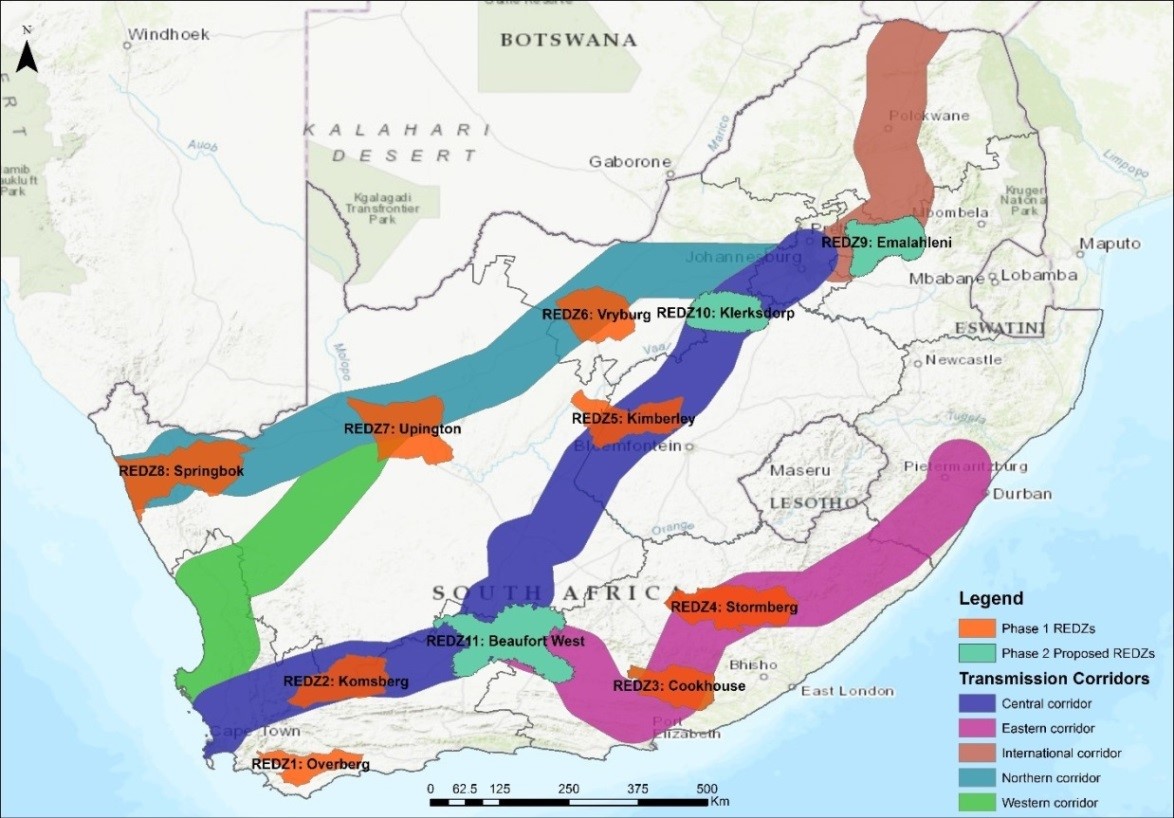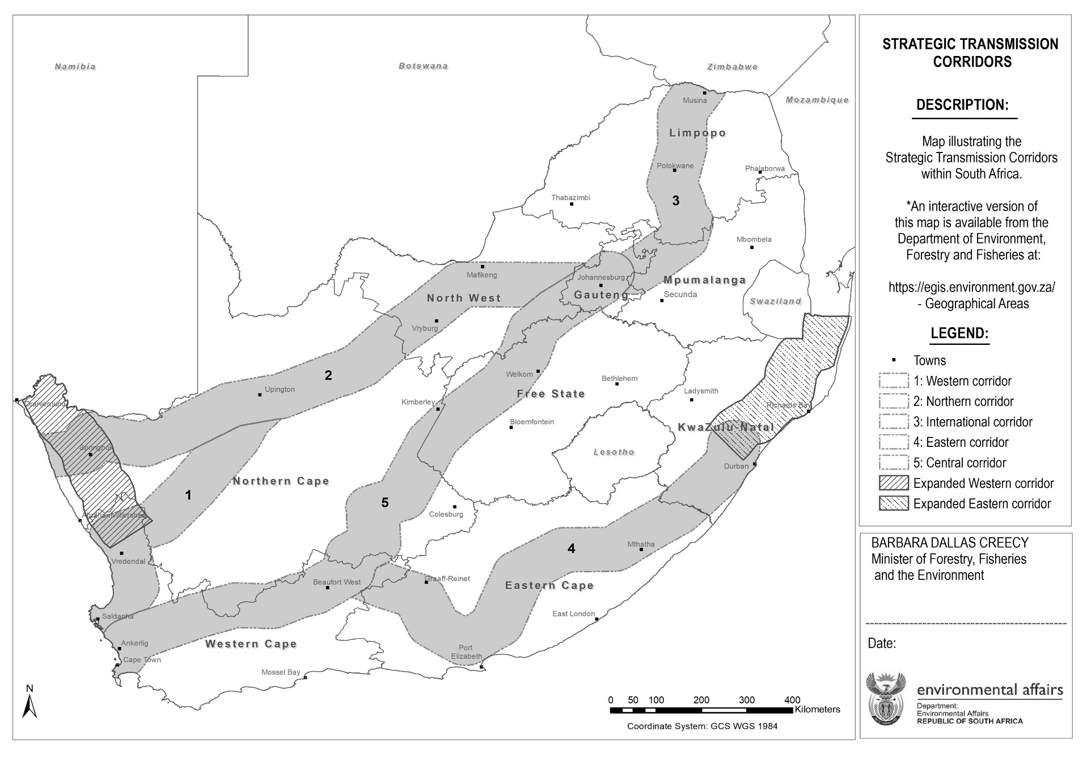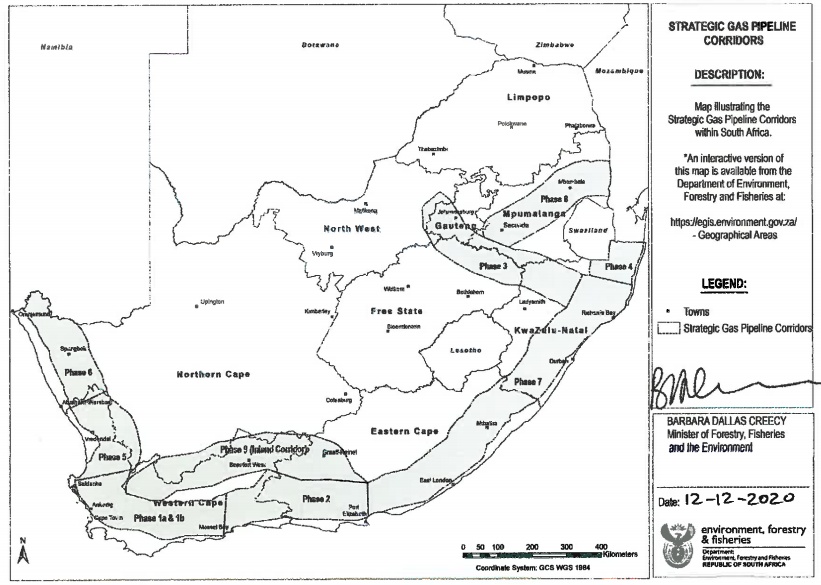In South Africa, all large-scale wind and solar photovoltaic (“PV”) projects and large-scale electricity transmission and distribution infrastructure require an Environmental Authorisation (“EA”) in terms of the Environmental Impact Assessment Regulations, 2014 (“EIA Regulations”) under the National Environmental Management Act 107 of 1998.
In 2015 and 2016, the (previously named) Department of Environmental Affairs (“DEA”) commissioned the Council for Scientific and Industrial Research (“CSIR”) to complete a series of Strategic Environmental Assessments (“SEAs”) to determine the environmental implications of the Government’s renewable energy policies and plans. Through the SEAs, the CSIR identified eight Renewable Energy Development Zones (“REDZs”) across South Africa that are of strategic importance for large-scale wind and solar PV energy development as well as five Strategic Transmission Corridors that are important for the rollout of the large-scale electricity infrastructure required for the energy projects within these areas.
In order to encourage the development of large-scale wind and solar PV projects and the associated large-scale electricity infrastructure, the DEA published Government Notices 113 and 114 on 16 February 2018 which provide that wind and solar PV projects that take place within a REDZ and electricity infrastructure that takes place within a Strategic Transmission Corridor only require a Basic Assessment (“BA”) and do not need to undergo the longer and more comprehensive Scoping and Environmental Impact Reporting (“S&EIR”) process in order to obtain an EA. This is because these areas have already been scoped for environmental risks as part of the SEA process. In addition, the DEA reduced the timeframe for the processing of these applications from 107 days to 57 days to help fast-track EA applications.
Any large-scale wind and solar PV or electricity infrastructure development activities that take place outside these specified areas are subject to the EIA Regulations. This means the more onerous S&EIR process may be required and a decision regarding the EA application could take up to 107 days instead of 57 days. Developers are therefore incentivized to develop wind and solar PV projects and electricity infrastructure within the REDZs and Strategic Transmission Corridors, respectively.
New Notices published by the Minister of Environment, Forestry and Fisheries on 26 February 2021
Following the publication of the 2019 Integrated Resource Plan (“2019 IRP”) and the publication of further SEAs on energy development in 2019, the Department of Environment, Forestry and Fisheries (“DEFF”) published a series of draft notices on 17 and 31 July 2020 which seek to provide additional areas of strategic importance for energy development in South Africa.
The proposed introduction of the additional areas of strategic importance aims to meet the goal of the 2019 IRP to diversify the energy mix by reducing the country’s reliance on coal and increasing reliance on renewable energy technologies. In an attempt to reduce greenhouse gas emissions and strengthen energy security, the 2019 IRP envisages that 6 000MW of solar PV new generation capacity and 14 400MW of wind new generation capacity will be added to the energy mix by 2030. This accounts for roughly 58% of the new generation capacity that is proposed by the 2019 IRP.
On 26 February 2021, the Minister of Environment, Forestry and Fisheries (the “Minister”) published new notices that identify three additional REDZs, the procedures to be followed when applying for or amending an EA authorising development within these areas as well as nine new Strategic Gas Pipeline Corridors. These final notices are largely based on the draft notices that were published in July 2020 and aim to boost the development of large-scale wind and solar PV projects as well as electricity and gas transmission infrastructure across the country.
The main aspects introduced by DEFF have been outlined below:
- Large-scale Wind and Solar PV Development Activities (as per Government Notices 114, 142 and 144)
Government Notice 144 sets out the three additional REDZs that have been identified by the Minister, namely: (i) Emalahleni in Mpumalanga, (ii) Klerksdorp in the North West (including parts of the Free State) and (iii) Beaufort West in the Western Cape.
Figure 1: Map showing the eight REDZs (in orange), the three additional REDZs (in blue) and the Strategic Transmission Corridors (discussed below) [Map source: CSIR]
Following the publication of Government Notice 144, South Africa now has the following REDZs (as shown in Figure 1):
- Overberg (Wind and Solar)
- Komsberg (Wind and Solar)
- Cookhouse (Wind and Solar)
- Stormberg (Wind and Solar)
- Kimberley (Solar)
- Vryburg (Solar)
- Upington (Solar)
- Springbok (Wind and Solar)
- Emalahleni (Solar)
- Klerksdorp (Solar)
- Beaufort West (Wind and Solar)
The new REDZs have been specifically chosen based on the geographical characteristics of these areas to cater for wind and/or solar PV projects, the current land uses and access to infrastructure. Beaufort West has geographical factors that make it particularly suitable for wind projects. Emalahleni and Klerksdorp are more suited to solar PV projects and were identified as preferred locations because of their proximity to Gauteng (where there is a high demand for energy) and the fact that the projects could be developed on old mining sites and potentially make use of existing electricity infrastructure from previous mining activities. Given the decline of mining activities in both Emalahleni and Klerksdorp, the development of wind and solar PV projects in these areas would not only provide sustainable and reliable energy but would also boost job creation.
The new notices published by the Minister have extended the current position under Government Notice 114 so that now the decision-making timeframe for EA amendment applications (and not just EA applications) for wind or solar PV projects within a REDZ is 57 days. Interestingly, Government Notice 142 did not change the requirement that the “entire” proposed facility must fall within a REDZ in order for a wind or solar PV project to be allowed to follow a BA process (and not the longer S&EIR process). Draft Government Notice 841 published in July 2020 suggested that DEFF was considering altering this requirement to provide that only 90% of the development activities need to take place within a REDZ in order to be eligible to follow a BA process. DEFF has, however, retained the requirement that the entire wind or solar PV facility must fall within a REDZ to qualify for the BA timeframes.
- Large-scale Electricity Transmission and Distribution Infrastructure Activities (as per Government Notices 113 and 145)
Neither Government Notices 113 nor 114 cater for the situation where electricity infrastructure is to take place within a REDZ. The recently published Government Notice 145 therefore seeks to address this by providing that where the “greater part” of the electricity infrastructure activities take place within a REDZ, an applicant for an EA must follow the BA process. If, on the other hand, the greater part of these activities fall outside a REDZ, the relevant procedure in terms of the EIA Regulations must be followed to obtain an EA (which may be the S&EIR process). Government Notice 145 further provides that the timeframe for processing the EA application or an EA amendment application is 57 days.
DEFF has also developed the: (i) Generic Environmental Management Programme (“EMPr”) for the Development and Expansion of Substation Infrastructure for Transmission and Distribution of Electricity and (ii) the Generic EMPr for the Development and Expansion of Overhead Electricity Transmission and Distribution Infrastructure which are intended to replace the need for a site specific EMPr when they are implemented.
In addition to the REDZs, South Africa currently has five Strategic Transmission Corridors across the country. On 17 July 2020, the Minister published draft Government Notice 787, which identified two further Strategic Transmission Corridors, namely: the Expanded Western Corridor and the Expanded Eastern Corridor.
The Expanded Western Corridor is necessary to connect South Africa to Namibia for possible gas-to-power generation, as well as the facilitation of renewable energy integration. The Expanded Eastern Corridor, on the other hand, is required to connect South Africa to Mozambique for possible imports from Mozambique due to anticipated high gas production.
Figure 2:Map showing the Strategic Transmission Corridors and the proposed additional Expanded Western and Eastern Corridors [Map source: DEFF]
If draft Government Notice 787 is finalised, South Africa would have the following Strategic Transmission Corridors (as shown in Figure 2):
- Central Corridor
- Eastern Corridor
- International Corridor
- Northern Corridor
- Western Corridor
- Expanded Western Corridor
- Expanded Eastern Corridor
The current position under Government Notice 113 is that if the “greater part” of a proposed large-scale electricity transmission and distribution facility is to occur within a Strategic Transmission Corridor, a BA process must be followed to obtain an EA. In July 2020, however, DEFF published draft Government Notice 835 which provides that where 90% or more of the electricity transmission and distribution infrastructure or the expansion of such infrastructure is to take place within a Strategic Transmission Corridor, an EA will not be required.
In a media statement issued on 25 August 2020, the DEFF explained that the reason for excluding electricity infrastructure activities that take place within a Strategic Transmission Corridor from the requirement to obtain an EA is due to the fact that South Africa has been “developing grid infrastructure for many years and the impacts and mitigation measures are well-known”. The DEFF has accordingly developed a standard known as the Standard for Electricity Transmission and Distribution Power Line Development within Identified Geographical Areas (the “Standard”) which will set out the activities that will not require an EA and the applicable procedures. Although these activities will not require an EA, they will still be subject to public participation and relevant appeal procedures. According to the DEFF media statement, the Standard “will reduce the timeframe between conceptualising a grid expansion project to its implementation, and means that energy can be provided to the user faster or on time in the case of new renewable energy developments”. If more than 10% of the proposed electricity transmission and distribution infrastructure fall outside the Strategic Transmission Corridors, the relevant procedure in terms of the EIA Regulations must be followed to obtain an EA (which may be the S&EIR process).
It will be interesting to see whether DEFF will declare the two additional Strategic Transmission Corridors identified in draft Government Notice 835 as Strategic Transmission Corridors and whether the provision that an EA will not be required where 90% or more of the electricity transmission and distribution infrastructure or the expansion of such infrastructure is to take place within a Strategic Transmission Corridor will be confirmed in a final notice.
- Gas Transmission Pipeline Infrastructure (as per Government Notice 143)
In accordance with Operation Phakisa, the initiative introduced by the Government in 2014 to fast-track the implementation of solutions on critical development issues, the DEFF has been considering various pipeline networks to enable successful offshore oil and gas exploration. Accordingly, the DEFF commissioned the CSIR to conduct SEAs on the development of a phased gas pipeline network in South Africa. The 2019 SEA identified nine Strategic Gas Pipeline Corridors that would be suitable for the development of gas pipeline networks. The nine Strategic Gas Pipeline Corridors (shown in Figure 3) have now been formally identified by the Minister in Government Notice 143 on 26 February 2021.
Figure 3:Map showing the nine new Strategic Gas Pipeline Corridors [Map source: Government Notice 143]
Following the publication of Government Notice 143, South Africa now has the following Strategic Gas Pipeline Corridors (as shown in Figure 3):
- Phase 1a & 1b: Saldanha to Ankerlig and Saldanha to Mossel Bay
- Phase 2: Mossel Bay to Coega
- Phase 3: Richards Bay to Gauteng
- Phase 4: Mozambique (Southern Border) to Richards Bay
- Phase 5: Abraham Villiers Bay (Northern Cape) to Saldanha
- Phase 6: Abraham Villiers Bay (Northern Cape) to Oranjemund
- Phase 7: Coega to Richards Bay
- Phase 8: Rompco Pipeline Corridor
- Phase 9: Inland Corridor from Saldanha to Coega
On 31 July 2020, the Minister published draft Government Notice 836 regarding DEFF’s intention to identify the procedures to be followed when applying for or deciding on an EA for the development or expansion of gas transmission pipeline infrastructure when occurring in Strategic Gas Pipeline Corridors. Draft Government Notice 836 provides that where 90% or more of activities relating to the development of gas transmission pipeline infrastructure or the expansion of such infrastructure occur within a Strategic Gas Pipeline Corridor, an applicant for an EA must follow the BA process. The draft notice further provides that the timeframe for the processing of an EA application or an EA amendment application would also be 57 days, as is the case in respect of large scale wind and solar PV facilities and electricity infrastructure that occur within a REDZ. If more than 10% of the infrastructure falls outside a Strategic Gas Pipeline Corridor, the draft Government Notice provides that the relevant procedure in terms of the EIA Regulations must be followed to obtain an EA (which may be the S&EIR process). The DEFF has also developed a draft Generic EMPr for Gas Transmission Pipeline Infrastructure (2020) which is intended to replace the need for a site specific EMPr when it is implemented (as per draft Government Notice 834 which was also published on 31 July 2020).
Now that the Strategic Gas Pipeline Corridors have been formally identified, we anticipate that DEFF will publish notices outlining the adoption of a generic EMPr for gas transmission pipeline infrastructure and EA procedures fairly soon. We will continue to monitor these developments.
Conclusion
The recent notices illustrate the Government’s attempt to boost the South African economy by diversifying the country’s energy mix and promoting electricity and gas transmission infrastructure development. The addition of more REDZs will also help to encourage the development of further wind and solar PV projects and facilitate the country’s “just transition” towards a low-carbon economy.
Should you have any queries regarding the notices, please do not hesitate to contact us.




